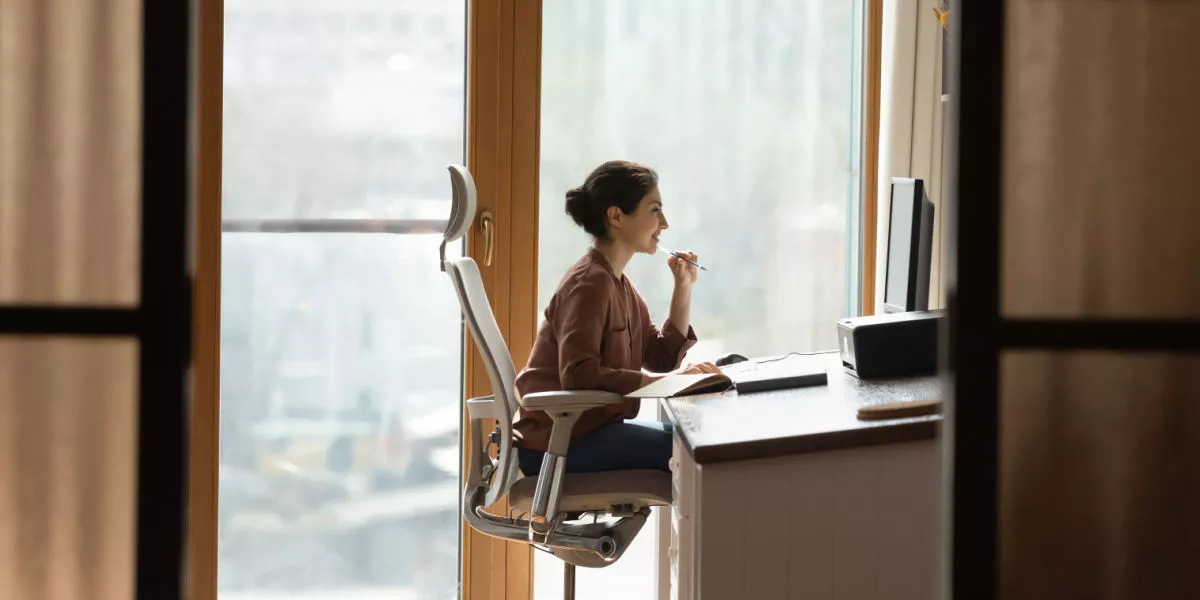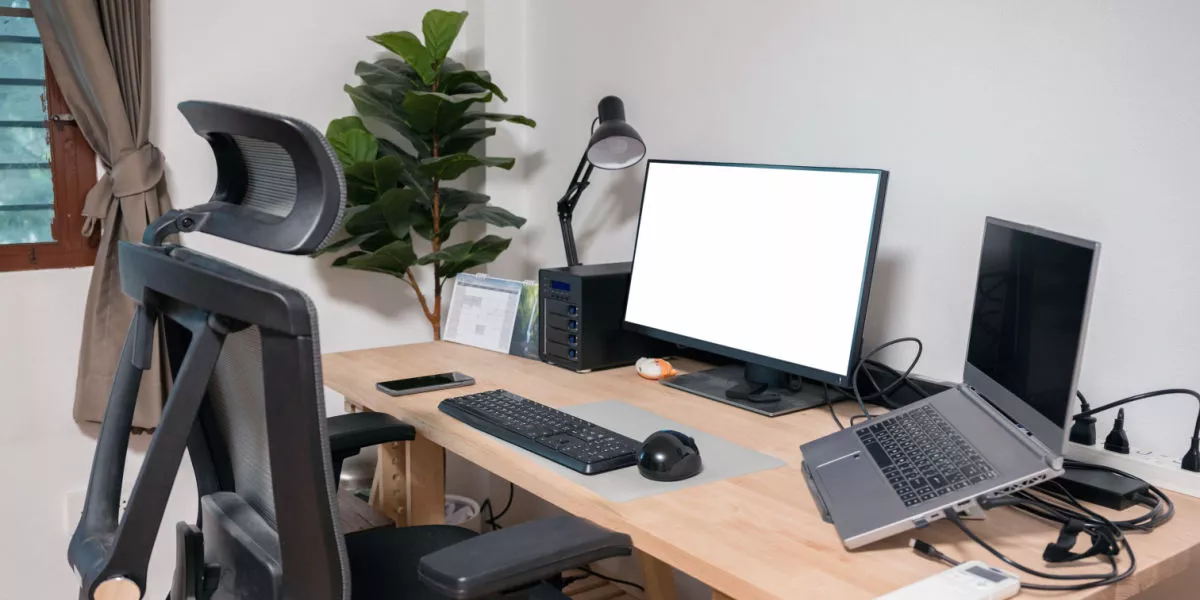A helpful guide to hybrid furniture for hybrid office workers

Hybrid work has fast become the norm for information workers in Australia. The concept of working both in an office and from home has experienced an increase from 8% to 40% in a few short years, as per federal government data.
This modern working model is not only a trend in Australia, it's also picking up speed around the world. A recent study by global analytics firm Gallup revealed that 49% of all workers engage in hybrid work arrangements.
With more workers splitting their time between home and the office, both employees and employers need to rethink what office furniture best fits a hybrid workplace.
Discover how to create a comfortable and productive workspace for hybrid office workers by reading this helpful guide.
What is hybrid furniture?
Given the shift to hybrid work, there’s a growing need for hybrid spaces – areas that can function as a workspace as well as a living space. This means there’s a necessity for furniture within these areas that can play both office and leisure roles, depending on business or individual needs.
Examples of hybrid furniture for offices include modular curved sofas for collaboration, sound-absorbing mobile floor screens to separate spaces, or even collapsible meeting pods to create private workspaces.
Hybrid furniture examples in the home include storage benches, pop-up coffee tables, ottomans designed to double as chairs, bookshelf room dividers, and ergonomic chairs.

Benefits of hybrid furniture
There are multiple benefits of hybrid furniture. First, there’s the ability to help separate personal time and work time. As Employsure points out, this is important as keeping work and personal spaces differentiated at home has benefits for mental and physical health.
There are also the space-saving qualities of hybrid furniture to consider. For many workers, space at home is at a premium, meaning furniture solutions that save space and perform multiple roles can help to configure a home office that fits with apartment living.
This is especially relevant when multiple people are working hybridly under one roof. The reality of many hybrid workers coexisting with family or friends makes innovative solutions for WFH essential. The same goes for furniture.
Incorporating hybrid furniture into the office and/or home also comes with challenges. Among these is the emergent nature of the area, meaning there’s limited data to back up the claims made by furniture makers on performance and quality. Also, hybrid furniture – as it is built to perform multiple, and sometimes complex, roles – often comes with a hefty price tag.
What are the features of a hybrid office?
For businesses, the hybrid model means a rethink of office design resulting from two main workplace trends – fewer staff in the office and employees spending less time there.
As global professional services firm PwC notes, these shifts mean a hybrid office looks different to offices of the past. Primarily, it’s not designed to accommodate all activities associated with work but instead provides a place for tasks to be completed that can’t be carried out in a home office. As such, the conceptual bases of a good hybrid office should be concentration, collaboration, communication and contemplation.
The big challenge for businesses catering for hybrid workers is striking the right mark on each of these metrics. PwC suggests the focus for enterprises embarking on the journey should be creating space where people, tech, and processes integrate to enable highly productive work, irrespective of whether staff are in-office or remote.

Hybrid furniture in focus
Delving deeper, there are several key considerations for hybrid office furniture. With fewer staff in the workplace, the hybrid office typically sees fewer desks required, with remaining workstations adapted to the varied needs of staff members using them on a particular day.
That’s why hot desking has become a popular option for many businesses, with height-adjustable desks a smart and easy way to give workers flexibility and comfort as they shift around the office.
Ergonomic chairs are also a popular feature of the hybrid office given they allow workers to tailor settings to their individual specifications.
Additionally, so-called ‘greening’ of the office – placing indoor plants throughout the workplace – is in vogue, with proponents such as Selmar Institute of Education claiming it helps to create a calming atmosphere and helps to bridge the tonal gap between home and office.
Hybrid office design is also increasingly seeing the use of collaboration spaces. Here, collaboration is often achieved via creative desk layouts as well as so-called ‘breakout areas’ for increased flexibility and dynamic working that encourages collaborative engagement.
While these are all popular elements, there’s no one-size-fits-all solution on hybrid furniture and it will always involve doing what’s right on things like workplace structure, flexibility, real estate and culture. Furthermore, hybrid workplaces should prioritise the needs of leaders and individuals, as well as the nature and style of work, organisational culture and values, and goals.
Best practices for employers
Under a hybrid working model, businesses are adapting furniture to workplace changes that have taken place in just a few years. While this can no doubt be a tricky process, it can be done.
Downsize office space
The rise in WFH means office space in Australia is roughly 47% occupied, with many companies using their full space just a few times a week. As commercial rents remain high, paying for this non-used space is a major sunk cost. As a starting point, many businesses embracing hybrid are downsizing office space and then adopting a flexible design approach.
Some businesses start on the hybrid design journey by incorporating multifunctional spaces and furniture, that allows open-plan areas to be temporarily repurposed for meetings, according to real estate company JLL. This approach gives businesses options to scale capacity up or down in line with changing occupancy and need.
Utilise technology
Before investing in lots of hybrid furniture – whether it’s private office cubicles, modular seating, soft workspaces or hot desks – it pays to get office technology right first. That’s because hybrid workers, irrespective of the furniture and design layout at the office, will only be productive if they have the technology and tools to assist in getting their work done.
Business leaders should assess what tech is required to facilitate hybrid work. Often this means investing in headsets and video call systems, as well as making sure workers can easily print, scan and share files at a moment’s notice. By investing in a Brother Multi-Function Centre with print, scan and copy functionality, your staff will be able to maintain the creation of high-quality work in or out of the office.

Stay flexible and mobile
The next step is to choose office furniture that has maximum flexibility and mobility. Taking this course will help to save the business time and money down the track on major office reconfigurations. For example, using lots of modular furniture enables spaces to be used for varied purposes, rather than having to retrofit permanent office fixtures down the track.
Prioritise ergonomic design
Ergonomic design is also key. At a hybrid workplace where shared work zones usually take up a lot more space than in a traditional office setting, it’s important to have ergonomic furniture that suits a variety of different users on metrics like age and gender. Remember, ergonomic furniture encourages increased comfort, better posture, and reduced back pain.
Brands such as Sydney-based furniture startup Recess are now specialising in the creation of modular, ergonomic furniture that is perfect for the modern, hybrid office.
Cultural change takes times
Transforming to a hybrid workplace is not all about physical office changes. It also means getting staff onboard with the project and familiarising them with how the new space can, and should, be used. This may not happen quickly, but it’s an important process to get right.

Best practices for employees
Workers are driving the trend to hybrid. Indicatively, a recent Swinburne University survey showed that Australian workers want greater choice in their location of work with 78% of respondents wanting to go hybrid.
Considerations on furniture for the home will vary depending on factors like the space available, how much time is spent working from home, and budget. The answers will determine if the right furniture is something small-scale, like a foldaway desk, medium-scale such as a desk within a wardrobe, or large-scale like a garage conversion.
Regardless, it’s key to get home office furniture correct as it’s well known that the physical environment, including furniture, is a factor impacting physical and mental health. As such, when it comes to home office furniture for hybrid work, there are a few must-haves:
Ergonomic chair and desk
Just as at the office, an ergonomic home office chair and desk is fundamental. These are must-haves because there’s evidence that for home-based workers, good ergonomics boosts productivity by curbing risk factors for musculoskeletal problems, including back injuries.
Additionally, there’s the benefit of increased morale, as attention to ergonomics can make employees more comfortable and relaxed day-to-day, as well as reducing absenteeism.
On home office furniture, an ergonomic desk sits right at the top of the list. It’s likely to be a big piece of the puzzle given, as just over a quarter of Aussie workers have an adjustable desk (27%) while fewer than half (46%) have an ergonomic chair.
Start with your desk and then work from there. For all the information and tips you need, read our helpful guide on setting up an ergonomic desk.

Other ergonomic accessories
It’s more than just the basics that are needed for good home office ergonomics, with a host of furniture accessories available to assist good posture and health while in front of the screen. These include a lumbar support pillow, footrest, seat cushion, and mouse pad.
Good lighting
Another furniture essential for a home office is good lighting. Perhaps obvious, it’s nonetheless often overlooked by remote workers, even though lighting is shown to also impact productivity and wellbeing, according to sources such as Human Resources Director. When it comes to desk lamps make sure to look for a highly adjustable physical design, variable colour, temperature and brightness settings.
Connectivity and office tools
You also need good connectivity at home to keep you online and in contact with your coworkers.
Best practice on this front also means having high-quality, internet-connected office tools, such as a multi-function printer from Brother's INKvestment range. Designed for easy-to-use mobile and cloud connectivity, most of these devices allow you to print, scan and manage your documents from the convenience of your smartphone or share documents with scan to email or cloud storage.

If you're suffering through unstable and/or slow internet speeds, it’s also worth looking around for deals on Wi-Fi boosters. These small devices extend your wireless internet connection throughout the home, either by repeating signals or creating a new network. This may be particularly important if you’re located regionally, or work from various parts of the home and encounter internet black spots from time to time.
Document security
In industries like legal and finance, just because you’re working from the home office doesn’t detract from the employer’s confidentiality obligations. For workers in these areas, it’s necessary to consider how to keep physical documents safe and secure in the home office. Popular items to assist here often include a paper shredder or a document safe.
Home office pods
As covered earlier in this guide, having more than one person working from home is a reality for many households. This is where novel home office solutions can help. One emerging solution is the home office pod used to deliver a quiet workspace at home.
While it’s not going to be feasible for every remote worker, a home office pod could be something worth considering. Some pods can be delivered fast, can be set up in under an hour, and are relatively affordable – making them especially applicable for busy households.
Additionally, there are also more generic and DIY solutions available that can be tailored to your space. It’s worth researching home office pods in-depth before committing to installation as there is no one-size-fits-all approach.
Hybrid work is becoming increasingly common, making it vital to invest in furniture that fits your unique situation as an employer or worker. Taking the time to do this is crucial for achieving workplace success both now and in the future.
Finding the right hybrid furniture and technology
After exploring the benefits of hybrid furniture, it is clear that this modern solution has a lot to offer for businesses of all sizes. Not only does it save space and add functionality, but hybrid furniture can also enhance productivity and support remote work arrangements. As more companies prioritise flexibility and adaptability in their workplace strategies, hybrid furniture is becoming a popular choice.
However, it's important to consider the specific needs and goals of your business before investing in hybrid furniture. Is space optimisation a top priority? Do you have a remote workforce that requires flexible workstations? Are you looking to create a more collaborative work environment? Answering these questions and more will help determine whether or not hybrid furniture is the right fit for your business.
If you've decided that hybrid furniture is the way to go, Brother can help you create a fully functional workspace with our range of print and scan solutions. Our innovative technology allows employees to work seamlessly from anywhere, while our user-friendly devices make it easy for employers to manage and organise their documents. Plus, with features like mobile printing and cloud connectivity, you can ensure your team stays productive and connected no matter where they are.
Investing in hybrid furniture and Brother's print and scan solutions can take your business to the next level. Contact us today to learn more about how we can help you create a modern and efficient workspace.

Resource Library
Be the first to receive exclusive offers and the latest news on our products and services directly in your inbox




